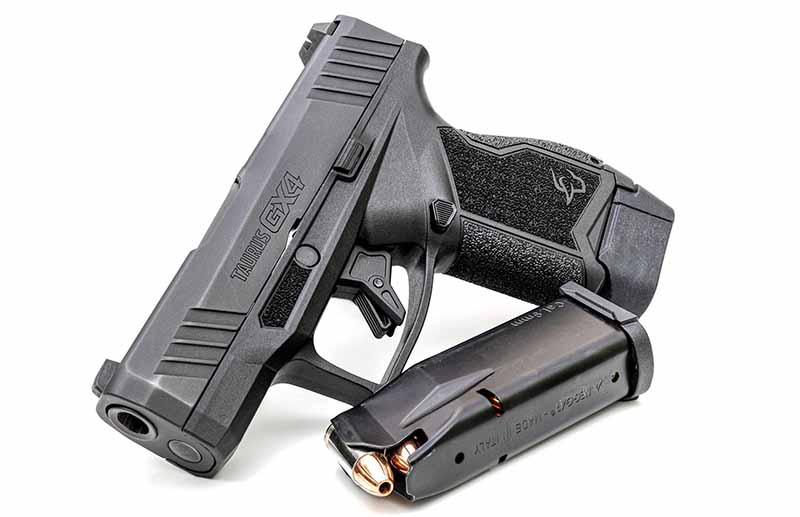Taurus handguns are a great choice for those looking for a quality gun. The Taurus GX4 is one of the most recent examples. Taurus began operations in Brazil in 1939 as a die and tool forging plant. They began manufacturing firearms in 1941 and then, in 1968, started exporting guns to the USA. It was almost 50 years ago that I first saw and touched a Taurus handgun. It was a nickel-plated revolver with a.38 Special, and it had a striking resemblance with a Smith & Wesson Model 10 The cylinder flutes were not serrated, which I found strange. The wooden grips were made of checkered wood and the curved trigger seemed to hang from the trigger guard. It was an “ugly duckling”, to be sure. Taurus bought the machinery from Beretta to make semi-automatic pistols. Taurus’ reputation was damaged in their early attempts at gun-making. Their semi-automatic pistols were manufactured by Beretta. I had tested several over the years and found that the revolvers performed well, but the autoloaders were a different story. I had problems with reliability and function, and the extractor on the Commander-size 1911 I was using fell out of the gun. But that was many years ago. I tested a Taurus Model 692 revolver, and then took it to Gunsite to take the 250 Revolver Course. There were no issues. Next, I tried one of the G3c subcompact 9mm pistols. I was so impressed with the Taurus product, that it has now become my semi-auto EDC. With the introduction of GX4, TaurusTaurus redefined the micro-sized pistol. The buyer receives many of the same features as a 9mm service pistol, but it has been reduced to the size of a single-stack.380 ACP. The barrel measures 3.06 inches in length and has a height of 4.48 inches. It weighs just 18.5 ounces empty. Add an 11-round magazine to the pistol and you have a dozen shots at 9mm performance in a pistol the size of your hand. The front blade features a recessed white dot, while the back side of the rear sight has finely serrated edges. The slide is made of stainless steel and has contours and bevels that align with the polymer frame. This gives the gun a smooth overall profile and makes concealment easier. The front sight features a recessed white dot. High-void serrations can be found on the rear and front of the slide. The muzzle end has been beveled on both sides for easier re-holstering. The barrel’s breech end is visible in the ejection port. A witness hole in its top acts as a loaded chamber indicator. The standard slide finish is a black-gas nitride treatment to ensure durability. The stainless steel barrel is coated with a DLC (Diamond-Like Carbon). Tungsten and Troy/Coyote Ceakote are two new options for slide finishes. These add a little more to the price. The control surfaces are Teflon-coated; the slide stop is plastic over-molded. The internal metal parts are nickel-plated so that everything works smoothly. They provide a firm gripping surface that allows for maximum control during rapid-fire shooting. They can be useful if you have difficulty gripping the pistol during rapid-fire shooting. The trigger guard has a stippled area on both sides that is an indexing point for your trigger finger. This can be used to attach your support-hand index finger to the trigger guard. The magazine’s magwell is located near the butt. This area can be used to remove the magazine from the magwell in the event of a malfunction. The magazine release is recessed for southpaws and reversible. The GX4 also comes with an extended base magazine with a 13-round capacity. For those who live in restricted areas, there is a 10-round mag. You can also get an 11-round magazine with finger rest. There are also magazines with a two round extension that gives you 13 rounds and a place to put your pinkie. These magazines are made in Italy from Mec-Gar magazine, blue steel with yellow plastic followers. You won’t get second-strike capabilities. What you will get is a consistent pull with an exact sear break and a quick, tactile reset. This trigger ensures maximum control and is ideal to use for quick follow-up shots. My Lyman trigger pull gauge measured 7.3 pounds. It’s not too heavy or too light. The take-up was minimal. Over-travel was also minimal. The GX4 is housed in a black plastic case with a safety lock and a manual. A replacement backstrap is also included inside. It has a more prominent palm swell, which allows for a more natural point-of-aiming for some shooters. The load comes in a zinc-coated steel box and contains a 151-grain FMJ cartridge. It’s a standard-pressure service load, similar to a.38 Special, and comes out of a 9mm pistol. Hornady supplied their Custom load, which comes with a 147gin XTP jacketed hollow point (JHP) bullet. National Police Ammunition also offered a 115-grain HELO Defense cartridge. The bullet is a monolithic, copper HP and has a black-colored coating. Steinel Ammunition supplied their Subcompact Carry load, which has a solid-copper HP of 124 grains. It’s striated almost from bullet base to tip. According to factory specs, it can achieve 950 fps from a 3-inch barrel. It did slightly better in the GX4. Finally, I tried some of the Super Vel fodder. It’s rated +P according to the yellow box. The bullet carries a 115-grain JHP cartridge that has a cone shape and zips. There’s always a pause between the introduction of a new gun and the availability of a suitable holster to carry it in. Crossbreed stepped in to save the day with their SnapSlide OWB holster and single magazine bag. It can fit a 1.75-inch belt slot and comes in a variety of options, including a sweat shield, leather or Kydex color variations. The magazine pouch is the same design and can be worn on the support-side hip. I found that the single magazine pouch is the same construction and worn on the support-side hip. This information is included in our ammunition performance table. One “hiccup” occurred with the Barnaul ammunition. However, it was not the most serious and the ammunition ran flawlessly the rest of the session. I also experienced an issue with the Super Vel cartridges. It appears that there was a problem with both the bullet shape and the overall length of my cartridge. The feed ramp was being pushed into by the sharp-edged jacket in the hollow nose cavity. After each shot, I had to “bump” my slide into the battery. Hoping that this would improve with more rounds fired I continued to use it through the accuracy potential section of my test. Given the barrel length of GX4’s fixed sights and short sighting range, I decided that 30 feet would suffice for my accuracy analysis protocol. I shot four five-shot groups using each test cartridge and sorted them alphabetically by manufacturer’s names. The Speer Gold Dot Carry Gun loads made my tightest five-shot group. A 1.14 inch group was my best. It was 2.09 inches on average. The Hornady Custom XTP took second place with a 1.29-inch five shot cluster and an average 1.79 inches. The performance table contains the remainder of the data. The Super Vel ammo problem persisted, so I withdrew the test. I wanted to do a practical evaluation to see how gear and gun would perform during a combat qualification course. This course requires 30 rounds and is short but realistic. I had two 11-round magazines with my GX4, and Taurus sent me two 13-round extended magazines. One of the extended magazines was loaded with 12 rounds. The other three magazines were each given six rounds. A full-color target for the bad guy was attached to my target stand. Guns & Rosa Targets LLC made it. It has B27-type scoring ring and the bad guy is holding a Glock pistol. He is aiming his muzzle at me! My course begins at 3 yards from my target. After taking an angular step back, the signal is given and I pull from my holster. Six shots are fired from a point-shoulder location using only my strong-hand. Six more rounds are fired and the pistol is immediately transferred to the support hand. After a reload, the target is engaged again. This time, both hands are in an isosceles-style position. The pistol is then placed in the low-ready state after two shots are fired center mass. The gun is raised for two more shots upon signal. After the proper procedure, the magazine is changed and the gun is re-holstered. Next, at 7 yards, is failure or body-armor drill. The pistol is pulled from the holster, and two rounds are fired center-mass and one to the head. The reload and re-holstering process is repeated. Finally, the pistol is drawn from the holster and two rounds are fired center-mass and one to the head. In my case, the barricade consisted of a small tree trunk placed at the stream’s edge. The gun is placed on the support-side barricade and fired two rounds after the signal was given. The shooter then moves to fire two more shots from the strong-side barricade. The shooter then moves to the strong-side barricade and fires two more shots. A stippled index point is located above the trigger. I was able to drop 24 points for a 276/300-2X score using the scoring rings. Except for two shots the bad guy was perforated inside the “boilerroom.” On a few occasions, the recessed magazine catch was difficultly manipulable and I had to rip out the magazines. It will work fine if it has a solid press. The combat course was flawless. The sights were easy to pick up and there were no problems. I think the Taurus GX4 is a great choice for night sights. It ran well with good ammunition. And, despite being small and light, it was easy to control in rapid fire mode due to the ergonomics and the “patches” that grab your hand. Yes, I would carry this pistol to protect myself, and others. Taurus’s unique features are that you won’t find them in any other handgun manufacturer for the same price. Storm Tactical’s impressive target pack includes62 printable targets for rifle and handgun range usage. Target grids and bullseye sizes can be found in MOA. Get Free Targets

This Weekend in New Mexico, two rifle efficiency shooting match
The 2025 Precision Tactical 2-Rifle Match will take place this trip, April 26 through April 27th, 2025 at the NRA Whittington Center in Coal Canyon, New Mexico. With eight dynamic
















